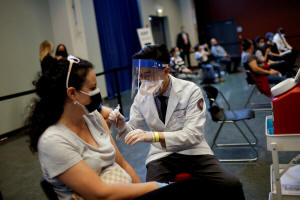|
The
United States earlier this week paused distribution of the J&J
vaccine to investigate six cases of a rare brain blood clot
known as cerebral venous sinus thrombosis (CVST), accompanied by
a low blood platelet count, in U.S. women under age 50, out of
about 7 million people who got the shot.
The blood clots in patients who received the J&J vaccine bear
close resemblance to 169 cases in Europe reported with the
AstraZeneca vaccine, out of 34 million doses administered there.
Both vaccines are based on a new technology that uses a modified
version of adenoviruses, which cause the common cold, as vectors
to ferry instructions to human cells.
The U.S. Food and Drug Administration is scrutinizing this
design behind both vaccines to see if it is contributing to the
risk.
In a letter on Friday in the New England Journal of Medicine,
J&J scientists refuted a case report published earlier this week
by Kate Lynn-Muir and colleagues at the University of Nebraska,
who asserted that the rare blood clots "could be related to
adenoviral vector vaccines."
In an interview with Reuters on Thursday, Dr. Anthony Fauci, the
top U.S. infectious disease expert and an adviser to the White
House, said the fact that they are both adenovirus vector
vaccines is a "pretty obvious clue" that the cases could be
linked to the vector.
"Whether that is the reason, I can't say for sure, but it
certainly is something that raises suspicion," Fauci said.
In the correspondence on Friday, Macaya Douoguih, a scientist
with J&J's Janssen vaccines division, and colleagues pointed out
that the vectors used in its vaccine and the AstraZeneca shot
are "substantially different" and that those differences could
lead to "quite different biological effects."
Specifically, they noted that the J&J vaccine uses a human
adenovirus while the AstraZeneca vaccine uses a chimpanzee
adenovirus. The vectors are also from different virologic
families or species, and use different cell receptors to enter
cells.
The J&J shot also includes mutations to stabilize the so-called
spike protein portion of the coronavirus that the vaccine uses
to produce an immune response, while the AstraZeneca vaccine
does not.
"The vectors are very different," said Dr. Dan Barouch of the
Center for Virology and Vaccine Research at Harvardís Beth
Israel Deaconness Medical Center in Boston, who helped design
the J&J vaccine.
"The implications of issues with one vector for the other one
are not clear at this point," he said in an interview earlier
this week.
The J&J scientists said in the letter there was not enough
evidence to say their vaccine caused the blood clots and they
continue to work with health authorities to assess the data.
A panel of advisers to the U.S. Centers for Disease Control and
Prevention are expected to meet on April 23 to determine whether
the pause on use of the J&J vaccine can be lifted.
(Reporting by Julie Steenhuysen; Editing by Bill Berkrot)
[© 2021 Thomson Reuters. All rights
reserved.] Copyright 2021 Reuters. All rights reserved. This material may not be published,
broadcast, rewritten or redistributed.
Thompson Reuters is solely responsible for this content.

|
|




